- US Dollar
- Euro
- British Pound Sterling
- Canadian Dollar
- Australian Dollar
- Home
-
SHOP ECO FARM
- ECO Farm Grow Lights
- ECO Farm LED Grow Lights
- ECO Farm Quantum Board
- ECO Farm Samsung LED Grow Lights
- ECO Farm COB Grow Lights
- ECO Farm Commercial Lights
- ECO Farm Supplemental Grow Light
- ECO Farm Fluorescent grow lights
- ECO Farm HPS & MH Grow Lights
- ECO Farm CMH Grow Lights
- ECO Farm HID/CMH Bulbs & Ballasts
- ECO Farm Grow Tents & Kits
- ECO Farm 2x2ft Grow Kits
- ECO Farm 3x3ft Grow Kits
- ECO Farm 3.3x3.3ft Grow Kits
- ECO Farm 4x4ft Grow Kits
- ECO Farm 5x5ft Grow Kits
- ECO Farm Grow Tent - Standard Style
- ECO Farm Grow Tent - Extension & Roof & Lodge Style
- ECO Farm Extraction & Harvest
- ECO Farm Rosin Press Machine
- ECO Farm Dry & Wet Trimmers
- ECO Farm Oil Accessories
- ECO Farm Medicinal Plants Grinder
- ECO Farm Medicinal Plants Containers
- ECO Farm Medicinal Plants Dryer
- ECO Farm Refrigeration Dryer
- ECO Farm Climate Control & Other Accessories
- ECO Farm Inline Duct Fans
- ECO Farm Oscillating Fans
- ECO Farm Exhaust Fans
- ECO Farm Air Filter
- ECO Farm Duct Muffler
- ECO Farm Ventilation Kits
- ECO Farm Plant Humidifiers
- ECO Farm Plant Dehumidifiers
- ECO Farm Hydroponic Accessories
- ECO Farm Other Accessories
- ECO Farm Hydroponics Microscopes
-
TOP BRANDS
- Grow Lights Brands
- Adjust-A-Wing
- Apollo Horticulture
- Bestva
- Black Dog LED
- California Lightworks
- ChilLED Grow Light
- Eco Farm
- HLG - Horticulture Lighting Group
- Kingled
- Kind LED
- Mars Hydro
- Morsen
- Neilo
- NextLight
- Phlizon
- PlatinumLed
- Roleadro
- Optic LED Grow Lights
- ViparSpectra
- Vivosun
- EYE Hortilux
- IPOWER
- NanoLux
- Phantom grow light
- Gavita grow lights
- Grower's Choice
- Lumatek
- Maxibright
- Yearld Pro
- ThinkGrow
- Crecer Lighting
- Green Sunshine Electric Sky
- fohse aries
- loriflux
- luxx
- fluence
- iluminar
- Lex
- LTC
- Rayonled
- FGI
- PHOTONTEK
- Grow Tents & Kits Brands
- Apollo Horticulture
- Black Box
- CoolGrows
- Eco Farm
- GrowLab
- Gorilla Grow Tents
- Mars Hydro
- Quictent
- Secret Jardin
- Unit Farm
- TopoGrow
- VIVOSUN
- Topolite
-
COMPANY INFO
-
COOPERATE WITH US
- Blog
ECO Farm G1 320W Foldable Quantum Board Pro VS Bloom Plus BP3000 Sunlike Full Spectrum LED Grow Light
October 25, 2021
Have you ever wondered how to use grow light to help your plants grow? It is time to take on the task and bear flourishing results. Why do you need to learn more about the use of grow light? The answer is simple. These days, most people live in apartments isolated from nature. Living in concrete jungles has its benefits. But it is a real struggle for gardeners and people who enjoy plants. You lack enough natural light to grow healthy plants and ensure proper photosynthesis processes.
We are here to solve the problem of natural sunlight and help you grow your greens using other options. What is needed to grow healthy plants within inadequate garden space? LED grow lights are perfect for growing different kinds of plants and keeping them strong even without natural sunlight.
What Are LED Grow Lights?
An LED is an electrical light that emits light through a semiconductor material that produces visible reds, greens, and blues. LEDs use up less power than traditional lights and can last up to 25 times longer than incandescent bulbs or fluorescent tubes. They also emit very little heat so they are safe to use around food crops and animals.
All plants require illumination in order to grow healthy. When growing your plants indoors, you will need artificial growth illumination to provide your plants with a reliable source of luminosity.
Major types of LED grow light
1. LED grow light panel
There are panels of square, rectangular or triangular shapes. Their ease of installation and versatility in use make them the most common model in horticultural lighting in a private home. There are generally offered with predefined color distribution according to the advertised use.
LEDs grow light panels in private use. The panel is a fairly widespread type of horticultural lighting because it combines several advantages, such as reasonable power, a large cover surface, and ease of installation, which makes it a fairly versatile piece of equipment.
They are made up of several dozen LEDs for the smallest model, up to several hundred for the largest. Their construction is quite compact, with a power supply and cooling system integrated into the same box as the led.
There are panels in the shape of a square, rectangle, or triangle, but the most common and the most practical shape is the rectangle, which is often more suitable for an area containing plants.
To install a panel, once unpacked, all you have to do is hang it above the plants using the fixing system provided, then plug it directly into the main socket.
2. LED grow light bar
LED mild bars are one of the pinnacle alternatives for indoor growers because of their software and insurance. Whereas furnishings may be cumbersome and hard to match into tight spaces, mild bars are typically longer and greater slim overall. This approach that they match notably into high-density manufacturing centers like maximum vertical farmers are using.
3. LED grow light bulb
Energy-saving, high efficiency.
Lamp life is over 30000 hours.
The lamp emits less heat while illuminating.
The lamp emits a high amount of photons to help plants have a high photosynthetic yield.
The lamp has a specialized light spectrum to help stimulate flower growth
ECO Farm G1 320W Foldable Quantum Board Pro
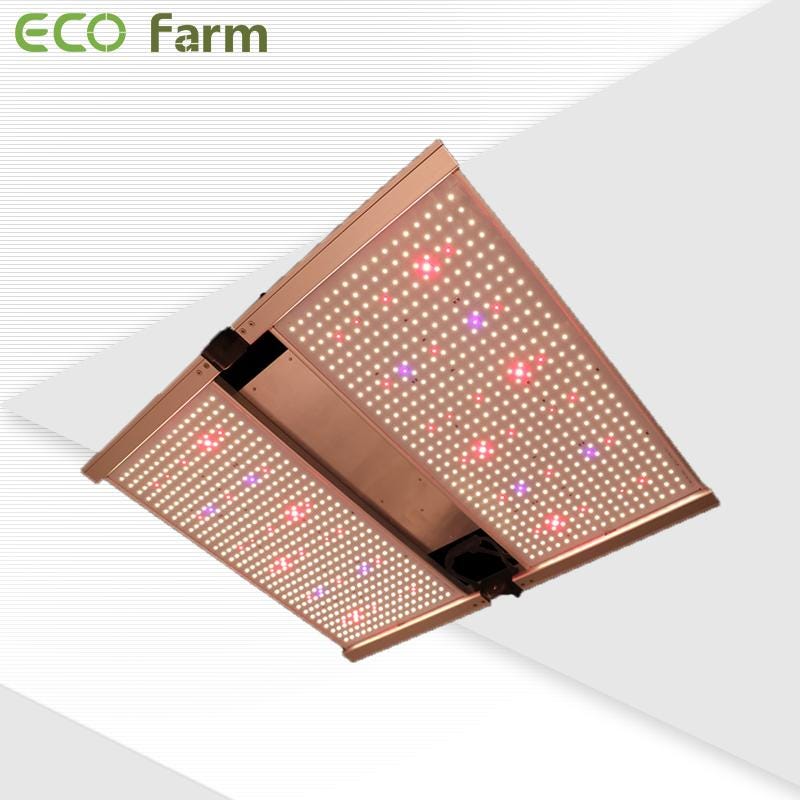
Features:
The ECO Farm LED grow light is designed with knob dimming, use LM301B/LM301H chip and can independently controlled UV&IR. High energy efficiency LEDs increase yield of crops and save operation cost, generates more usable lighting per watt and provides better light canopy penetration. Enhanced 3500K white-light full spectrum , which providing your plants with excellent full spectrum led grow lights. No fans zero noise. Large areas of solid aluminum heat sinks help you to achieve the ideal cooling system to achieve high PAR output, longer lifespan to speed up plant’s grow processes and boost yields while saving you on your energy bill. Comparable to traditional 1000W HPS/MH while consuming only 320W, which helps to get 50% higher yield harvest and save costs.
Bloom Plus BP3000 Sunlike Full Spectrum LED Grow Light
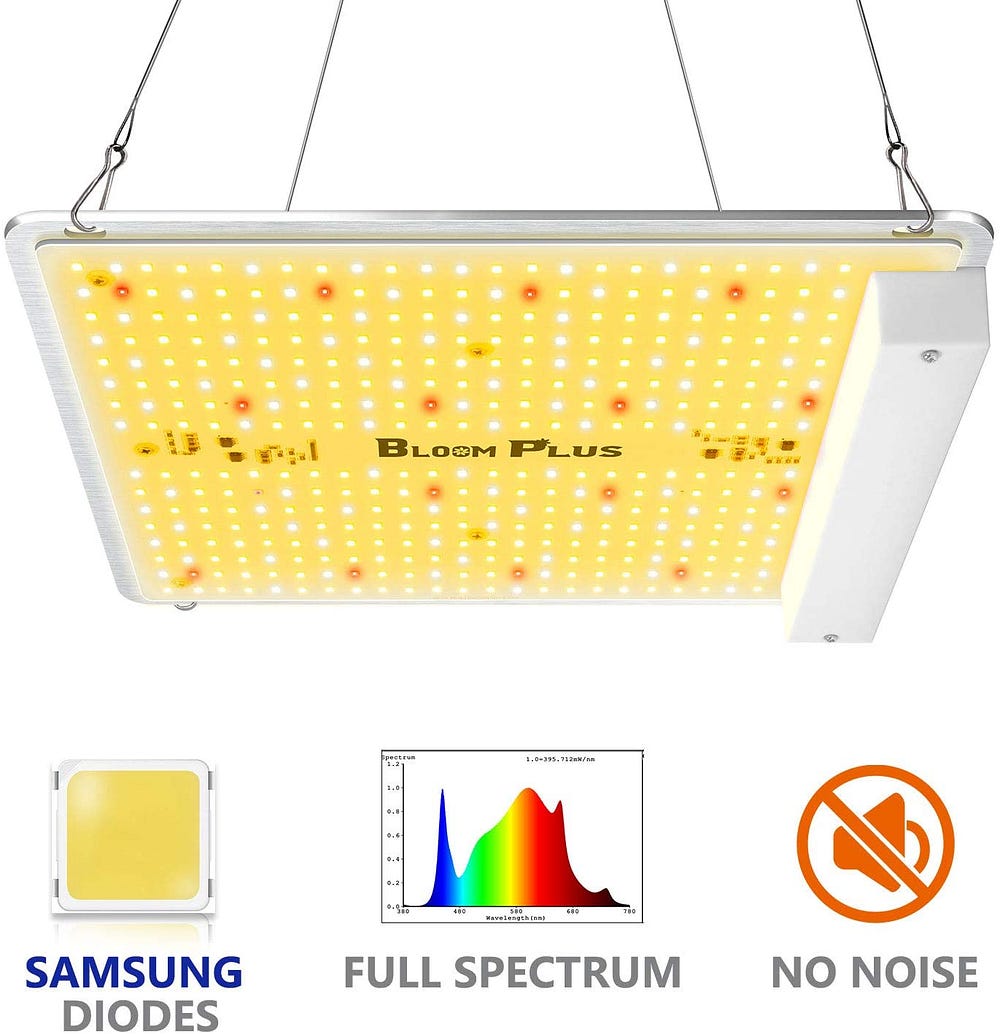
Features:
The Bloom Plus LED grow light uses the Newest high-yield LED technology-1174 pcs Samsung 2835 diodes. So BP3000 LED Grow Lights achieves a high energy efficiency of 2.7 umol/J and improves the light transmittance. The LED Growing Light consumes only 300W of power, which is 50% less than the operating power of other 600W HID/Blurple/HPS lamps, while help gets 50% higher yield harvest. The Full Spectrum led grow lamp can provide everything the plants need under light at all stages. The powerful blue light makes the plants grow faster, and IR light is particularly useful during flowering, it can accelerate bloom time and increase yield, fill the flowers with space and obtain an amazing harvest. A fanless design is used to provide you with a silent growth life.
How to select a grow light?
To choose a suitable grow light for your plants, you’ll want to make some adjustments to the light intensity.
First, you will want to figure out how many grow lights you have in your grow area. Then, you can figure out which grow lights give the best results. To find the best growing light, you should look at the average growth rate. If the average is low, you’re probably not going to get as much light as you would with the lights you use. If your average growth is high, you probably have a good grow light. That’s good, because it means you have good access to light and you can control the growth rate of your plants and their growth. You have to take into consideration the amount of light you use and the control of humidity. If they’re getting enough light, the humidity is low and you’re not getting as much growth, then you’re going to have problems. You’ll need to control humidity and temperature.
How do you control humidity?
The first thing you’ll need is to figure it out. How much humidity do you need?
You can set the humidity to a very low number and you’ll see the plants grow more slowly. That way, you don’ t need to keep it low. It’ll only take you a few days to see the effects of lowering the humidity. Then you’ll have to lower the humidity as you go. If it’s low, the plants can grow faster. They can grow taller. That will help you control your plants growth. But if you lower the temperature too much, you may have trouble controlling the growth. And if you keep the temperature high too much then the plants won’t grow as fast. So you need some adjustment to the humidity levels to control your growth. If there are too many plants growing at once, you won’t be able control the plant size. The plants will go into overgrow mode. You might have to go out of your way to keep the humidity low. If a lot is happening, you also might have problems keeping your plant growth in check.
What if I need more light?
If you’re using an indoor grow room, you’ve probably seen how to use a grow lights to grow vegetables. That can help to keep your plants from getting too crowded, but that’s about it. In a grow room you’ll also need some grow lights for your herbs and flowers. So this is another option. You’re going be growing a lot more plants than you would in a grow space.
Conclusion
LED luminescence comes with many advantages for indoor gardens as compared to other types of illumination. They are highly effective since they produce a wide range of colors required by plants. In case you have been considering purchasing a suitable model for your indoor garden, we hope that you have learned something from this guide.
Viparspectra Pro Series P4000 VS VIVOSUN Latest VS4000 LED Grow Light
October 23, 2021
Grow lights are designed to give plants the light they need for vital chemical reactions for healthy growth when the sun’s rays just are not enough. They are essential for plants in greenhouses so they can carry out the process of photosynthesis, while protecting from the rain, wind, animals, pests that damage the plants, and cold temperature.
How do you choose the best grow lights for your greenhouse? Keep reading on to find out.
What Kind of Growing Light Should You Buy?
When deciding on the type of row light to buy, there are so many factors you need to consider, including the following:
Fluorescent Lights
Fluorescent lights are good for growing vegetables. Vegetables require low or medium lights during the early stages. Choosing this type of light will be the best option because you will be sure of the positive growth of your plants without any risks.
Fluorescent produces lights of all colors needed; thus, choosing it ensures that your plants get enough colors needed during the early growth. The medium and low lights produced are friendly to the plants too.
They are affordable and last longer too.
The produced lights are mostly blue in color.
High-Pressure Sodium (HPS), also known as High-Intensity Discharge (HID)
HPS lights emit different wavelengths of colors. They produce red, yellow, and orange spectrum colors. Buying HPS is good for your plants at their early stages because it encourages the roots to grow stronger.
It also triggers the flowering process because of the red color that it produces, which looks like the natural sun produced during the summer season.
HPS is also good to use in the early growth stages of vegetables; you only need to use low watts that would not affect the general growth.
HPS also produces a high amount of light, so you should not be worried about its light’s sufficiency to the plant.
This is the best light to be used because of the strength of heat it emits; its heat is good for all types of plants. The only problem you might face with the price it is sold. It is more expensive than the other types of lights. But they are durable.
Light Emitting Diodes commonly known as LED
LED growth lights are good in indoor plants because they are cheap and plant-friendly too. The light produced is moderate and fits every plant well.
LED lights have both blue and red colors, which is the best for house planting.
The amount of light produced by these lights is low and does not have the risk of burning the plants if left for long on for longer hours.
LED lights work best if placed closer to your plants because the amount of heat produced is not too high.
These lights are good only for plants that grow in less heat like some types of grass.

Features:
The secret to VIPARSPECTRA grow light ’s success is optimal full spectrum lighting which provides plants in all stages from veg to flower with everything they need in the natural sunlight, turn your seeds into your own supply, produce beautiful high yielding plants. And make indoor planting become more easier and more convenient. This results in bigger buds and higher yield all while saving you on energy costs. IR light is particularly useful during flowering, it can accelerate bloom time and increase yield, fill the flowers with space and obtain an amazing harvest. The light makes indoor planting become more easier and more convenient. The light is ideal for all kinds of your indoor plants. Innovative fanless design, Large area of solid aluminum heat sink are excellent for heat dissipation. No need to worry about heat dissipation.
VIVOSUN Latest VS4000 LED Grow Light
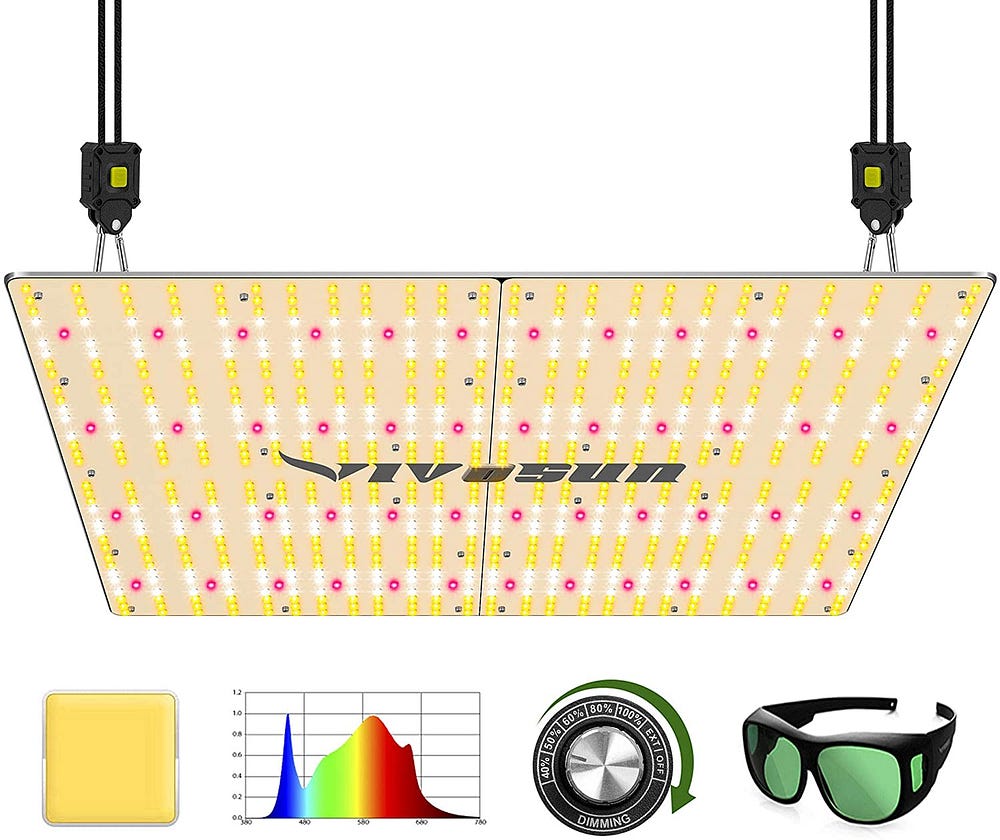
Features:
VIVOSUN LED grow light uses the latest LED plant light technology with Samsung LM301H diodes & brand driver for high energy efficiency with 2.9 umol/J; Extremely high output but consumes only 400W of electricity, making it more efficient than traditional HID lamps and other plant lamps on the market. This LED grow light has a dimming knob & ballast, so it adapts to different plant growth stages by adjusting its output from 40% to 100%; Super convenient for both beginners and professional growers. These Samsung VS4000 LEDs deliver the optimal full-spectrum coverage and power needed by your plants at all growth stages, with maximum PAR output at various distances, supporting efficient photosynthesis for indoor plants.
The Advantages of Using LED Grow Lights
Some of the benefits of buying the most decent models include:
Power efficiency- One of the major benefits of LED grow luminescence devices is that they do not consume a lot of electricity as compared to other luminescence devices. Thus, your power bills remain the same. This also means that you can leave them on for long hours without any problem.
Durable- Most of them have a lifespan of 50,000 to 100,000 hours unlike other types of luminescence devices which last for 20,000 hours or less. Again, they do not affect the temperatures of the room since they do not make the room too hot.
Space-saving design — In terms of design, these luminescence devices do not require a lot of space since they do not require extra equipment. They have a compact and portable design. So you can move them easily if you want.
Full-spectrum -The other reason why you need to consider LED grow luminescence devices is that most of them are tailored to suit the specific demands of your plants. This means that when using these lights, you don’t have to use different lights as your plants mature since they offer a huge spectrum of colors.
Healthy plants- Some luminescence sources such as the sun emits harmful UV rays. Other luminescence devices may cause your plants to dry or burn since they emit too much heat. Theseluminescence devices are very safe for your plants. As a result, they enhance the growth of healthier plants.
Conclusion
There are many automated greenhouse growth lighting options available to cater to different plant types and stages of growth. The range of supplemental growth to photoperiod control grow lighting options we mentioned above will make your greenhouse lighting a simple, efficient process.
Monios-L T5 LED Grow Light VS Grower's Choice TSL PFS Series LED Grow Light
October 22, 2021
Do you live in a place that doesn’t get much sun? Does your home naturally fail to let the light in at times? Or, perhaps your place gets enough natural sunlight, but you want to ensure the plants in your home are getting the light they need with no worries.
T5 grow lights are the answer. The flowers, herbs, and seeds you have planted will respond to this light like a charm.
However, you can’t just slap a few of these lights up and call it a day. Perhaps you already have some lights, but they aren’t optimal for your plant’s growth (such as T12’s or T8’s).
In this handy guide, we will get into all you need to know so choosing T5 Grow Lights is easy for you. Let’s begin with the selections for the best T5 grow lights and then go over some features.
Why Use a T5 Light?
For starters, they are great for beginners. T5 is a fine choice for those of you just starting out in the world of hydroponic growing. It’s great for those just starting out who don’t want to sink a huge amount of money into their growing right away.
T5 Lights Are Efficient
You need efficient lighting for a number of reasons. For starters, you want to keep your electric bill manageable.
Second, you need to make sure your plants are growing strong.
Third, you know that having a great light that works right the first time will get you the results you want.
Your goal is to look for lights with at least 100 lumens per watt, as this will give you the reliability you need to get the work done right the first time. All of the lamps we featured above have that or better.
Life of the T5 Lamp
Most T5 lamps will get you about 20,000 hours of work time. This means repurchasing bulbs will be a rare occurrence, and you will enjoy several successful growing cycles before it’s time to buy them again.
You may wonder about the quality of the lightbulb inside the lamp as it burns. You don’t even have to worry about that, as the bulbs start out powerful and remain that way as time goes on.
Your bulbs will last as long as the packaging states, and until they completely die out, there’s no need to replace them.
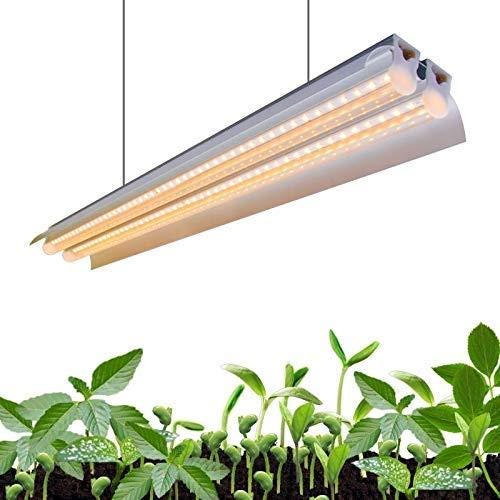
Features:
Monios-L led grow light with a full spectrum between 380–800nm, is the professional sunlight replacement for indoor plants. The 60W ultra-bright leds provide high PPFD ( photosynthetic photon flux density ), perfect for seedling, vegetative and flowering cycles. 2900K color temperature makes the light appear warm white, which is comfortable for your eyes. This grow light are suitable for planting or displaying plants in any indoor application, including plant grow tents, plant grow shelves, seedling cultivation, hydroponic rooms, etc. And it is equipped with High-quality LED chips and aluminium housing, the light efficiency is increased by 25%, which can perfectly meet the light needs of the great majority of plants throughout the growth cycle.
Grower’s Choice TSL PFS Series LED Grow Light
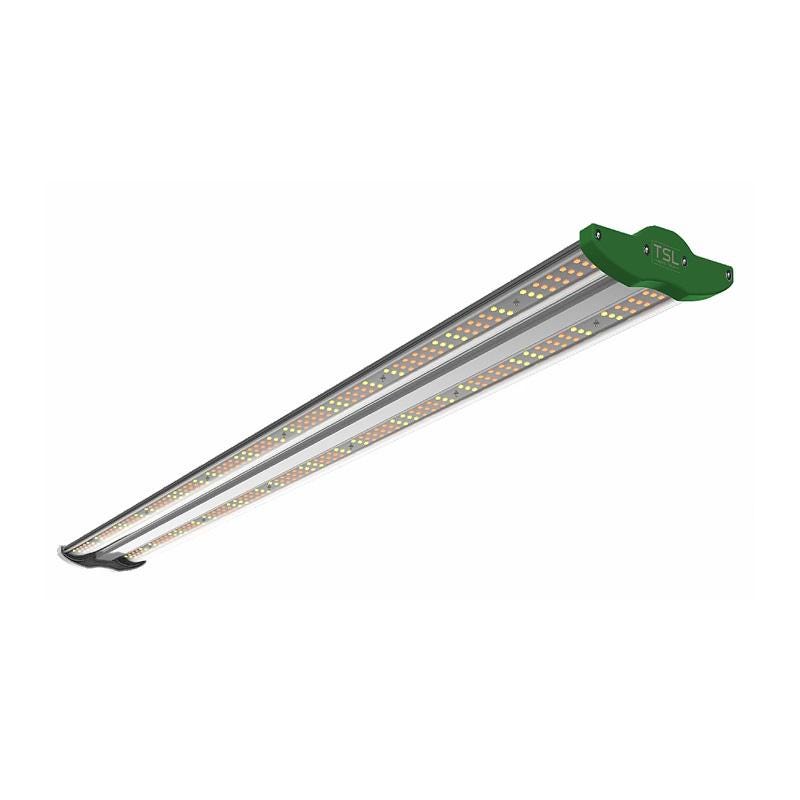
Features:
The Grower’s Choice grow lights are ultra-low profile (1.5 inches thin) and are created for dense vertical commercial farming where every inch of your indoor cultivation matters. Home growers will find these lights advantageous for their crops too! Stack layers from floor to ceiling of leafy greens, micro-greens, and culinary herbs with maximum efficiency at near-ZERO radiant heat with outputs as high as 2.7 umol/J. Ideal for the propagation of vegetable and ornamental crops including cloning/seedling beds with the lowest photosynthetic photon flux density. And it offers a perfect replacement for bulky traditional T5 fluorescent lamps. Ultra-lite design is stress-free in weight increasing harvest space for higher, quality yields for a positive impact on your bottom line.
When using T5 lights you need to be aware of four main things:
The height at which the lights are hung. It is crucial to hang the T5 lights at the right height because if they are too close to the plant canopies, the grow lights can do some serious damage to your plants. The optimal height at which T5 fixtures are usually hung is 6 to 8 inches above plant canopies. At this height, the T5 lights can provide the widest coverage while still providing powerful light to the plants.
The light cycle. This refers to the number of hours per day the grow lights are turned on and the plants are lit up and how many hours the plants spend in the dark. A general rule of thumb is that the more light plants get, the faster they grow, but keep in mind that there also are shade-loving plants that might require less light.
The temperature in the room. Anyone who has been in any type of photo studio knows it can get hot in there because the large studio lights illuminate and heat up a space. This also happens in the indoor lighted garden. Closely monitor the temperature of your grow space, especially if it is very small because a temperature of 85 degrees or higher can harm houseplants. If the temperature rises too high, ventilate the room in some way, such as opening a window, which allows the plants to cool off and breathe.
Watering. How much water your plants require depends on the temperature of the room and how quickly the plants grow. That’s why it’s critical to check the soil for water readiness. Water when the top one to two inches of soil has dried out.
Conclusion
Unfavourable weather conditions or insufficient gardening space cannot stop you from growing your favourite plants. You only need the best indoor grow lights for plants to watch your seedlings flourish in no time.
These grow lights provide the perfect growing conditions like light and heat that a plant needs for propagation and growth. So, whether you want to grow veggies or highly adorable succulents, compare your options and choose the best grow light.
These are easy to use, economical and ultraconvenient!
ECO Farm 60''x48''x80'' Grow Tent VS VIPARSPECTRA 60"x48"x80" 2-in-1 Grow Tent
October 20, 2021
Outdoor gardening is good, but there are so many factors you cannot control. You have to deal with pests, herbs, and weather uncertainty. If you are tired of battling with pests and harsh weather, you can move to indoor gardening. With indoor gardening, you can control many factors and grow your plants to full capacity.
While a hydroponic system is great, you first need a grow tent to contain your indoor garden. Once you contain the garden, it is easy for you to control other factors such as light, ventilation, grow media, nutrients, and the garden system among others. But what makes the best grow tent?
With so many options on the market, it can be challenging to pick one. In this article, we explore the top grow tents on the market and how to pick the right one.
How can you say that a grow tent is good?
A good grow tent that is of high quality should be able to replicate or similar outdoor conditions that your cannabis plants may need to grow. Your grow tents should also be conveniently accommodated indoors and should also complement your grow lights, ventilation units, and many more.
A good indoor grow tent should be able to:
Provide protection from bugs and other pests and animals as well.
Help prevent stale or dry air.
Improve growth efficiency and help in the maximum but smart utilization of power and electricity.
Aid in odor control.
Help the grow lighting systems achieve their maximum light output and coverage.
Are Best Indoor Grow Tents Worth the Money?
Without any doubt, yes. A grow tent is the most economical and convenient way to grow indoor plants in less space. In addition, the Mylar Fabric with reflective interior allows you to offer the best possible environment to the plants to enhance the yield.
You can’t have ideal farming conditions throughout the year. That’s why you buy a reusable indoor grow tent to grow the plants irrespective of the outside atmosphere.
Furthermore, a grow tent is lightweight and easy to assemble. You can even grow the plants inside your house or basement, spending upon the available space. Moreover, you don’t need to worry about the foul odor as the grow tent doesn’t let out the bad smell.
To sum up, an indoor grow tent is a one-time investment to provide the best possible growing conditions to your plants by controlling the light, moisture, and humidity inside.
ECO Farm 60'’x48'’x80'’ Grow Tent
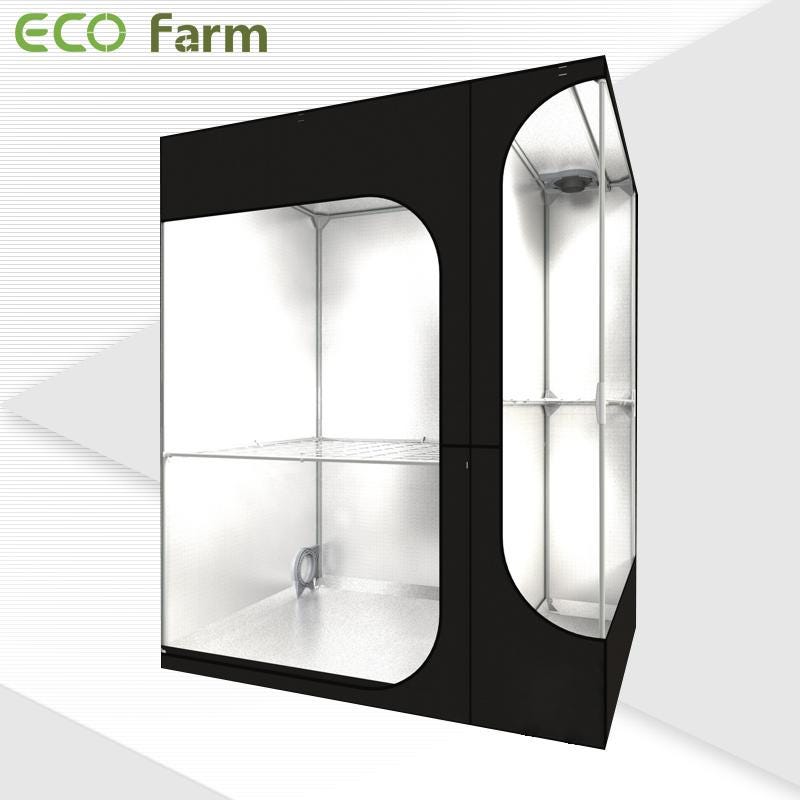
Features:
This ECO Farm grow tent features one 64"X48"X80" large tent area room equals to a middle and large plant growing tent for vegetation and flowering that can keep your plant perpetual harvesting.Durable 600D oxford maylar outside and high-reflective waterproof diamond Mylar inside(enhance the reflective effect),Large heavy duty Zippers & Double Stitching and also 2 Mylar around the zippers for protection against light leaks. The grow tent blocks all light from escaping and is lined with 98%-reflective mylar to boost the output efficiency of any grow tent setup.Rectangle vents with mesh for better ventilation and multiple vents for fan and filter output, Easy entry and access. The grow tent features with three separate growing areas, allowing gardeners to manage plants in different stages of development while remaining compact for small spaces or areas with little height. You could grow seedlings at the 2-tier small tent, and transfer them to the larger tent after they grow taller.
VIPARSPECTRA 60"x48"x80" Reflective 600D Mylar 2-in-1 Grow Tent
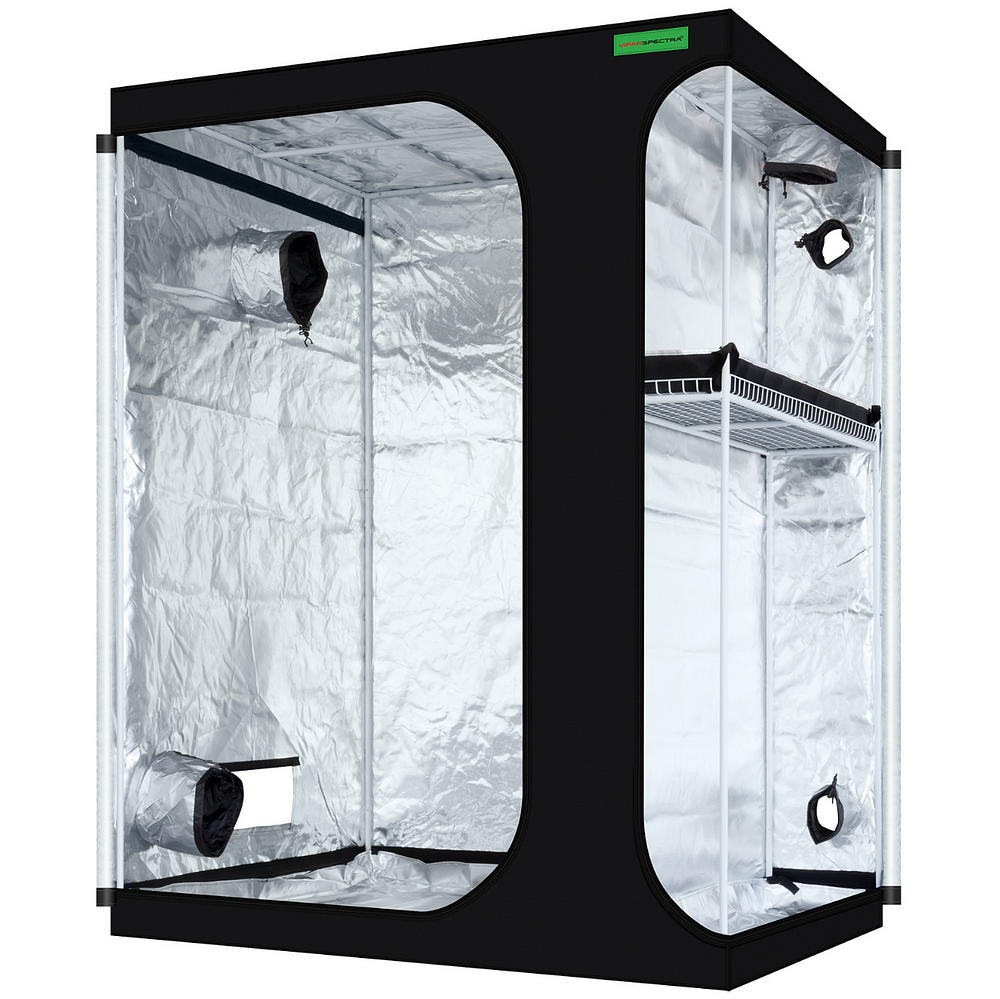
Features:
VIPARSPECTRA grow tent has three separate growing areas. 2-tier small compartment is for propagation & seedlings. One larger grow area is for vegetation and flowering. The main grow chamber and 2-tire small compartments separated by removable mylar baffle. The VIPARSPECTRA grow tent blocks light from escaping. The tear- proof canvas with heavy-duty zippers and double stitching ensure durability and long-lasting use. It is also lined with reflective mylar to boost the intensity of your grow tent set up. Multiple vents to accommodate fans and filter, ducting rectangle window with mesh to keep dust and insects out, better ventilation. Strong metal poles and solid metal corner connectors that will uphold your grow tent’s frame and lock your structure securely in place. It is a view sealed window with transparent plastic and removable cover. Easy-View window on the front side of door makes it easy and comfortable to take a peek inside and observe plant growth.
Things to Know Before Buying a Grow Tent
What is the benefit of using a grow tent?
A grow tent allows you more control over your indoor growing environment, leading to a more fruitful crop. It provides additional defence against any environmental factors. Additionally, it can allow you to influence the growth with your lights, medium, nutrients, system, and ventilation.
Is it easier to grow plants in a grow tent?
Generally speaking, grow tents are easier to grow plants in, but they require a little bit more effort in the setup stage. Once the tent is set up, you can more easily control the environment, resulting in an improved gardening experience.
What size grow tent should I get?
The size of your grow tent depends on what you intend to grow. If you are wanting to mother 1 to 2 plants, a 2’x2’ grow tent works great. The most popular tent sizes are 5’x5’ and 4’x8’ because they are suitable for 4 to 10 plants. If you have more than 10 plants, you will need to opt for a larger tent.
Will the grow tent mask any smells?
For most grow tents, you should not notice any smells until the flowering final phase. With the help of fans and carbon filters, you should be able to remove residual odors.
Can you use a grow tent outdoors?
You can put some grow tents outside, but not all. High-quality tents will be made from waterproof materials and sturdy frames. This makes high-quality tents suitable for outdoor use. With that being said, low-quality tents will not hold up well outdoors.
No matter if you have a high-quality or low-quality tent, you must be proactive in preventing bugs and holes. This can be difficult when the tent is outdoors, but it is necessary to get the full effects of the tent.
Conclusion
Hopefully, this article has given you a good idea of what size grow tent you need, in order to house the specific number of plants you are hoping to grow. And now that you know the exact size of your grow space, it is time to figure out what size grow light you need to light that area in order to maximize yields.
GreenBroz Model M Dry Trimmer VS Diamond Edge Dry Trimmer
October 18, 2021
Many first time growers don’t know how to trim cannabis plants once they’ve harvested them. With this article, we want to explain to you how to trim your weed plant.
First, you need to remove all the leaves until the buds are clean, which is the part of the plant that contains the most THC.
The leaves and stems also have THC in them but they don’t taste nice. You can use the smaller leaves to make extracts if you want.
The leaves on the cannabis plant are like their lungs. It’s where they receive the necessary light for the photosynthetic process, which is why there’s so much chlorophyll in that part of the plant. Chlorophyll is like blood for the plant and it gives buds that leafy green aroma and taste when they are fresh.
You can use the leftover trimmings to make BHO or other extracts. The only parts of the plant that we can’t make anything of are the roots.
What Is Cannabis Trim?
When we talk about the trim, we’re referring to the leaves that are intentionally pruned from the plant during a harvest. It shouldn’t be confused with a shake, which includes the loose leaves and stems that fall off naturally.
Shake is high in THC and other cannabinoids, while trim tends to have much lower cannabinoid content. For this reason, many growers simply discard their trim assuming that it has no value. However, when you realize all the things that can be done with those discarded leaves, you may think twice about tossing them aside.
Sugar Leaves vs Fan Leaves
Cannabis trim actually refers to two different types of leaves: sugar leaves and fan leaves.
Sugar leaves are the small leaves that grow out of the buds.
Fan leaves are the larger leaves that protrude from the branches.
If you’re hoping to turn your trim into a psychoactive product, fan leaves are virtually worthless. There are fewer trichomes and therefore fewer cannabinoids and terpenes. When making concentrates and other preparations, you want to focus on the smaller sugar leaves. These contain heavily concentrated trichomes, so they’re much better for various extractions.

Features:
The GreenBroz Model M Dry Trimmer is designed to closely mimic the act of hand trimming your harvest while at the same time increasing the consistency and efficiency of your harvest process. While the Model M is primarily designed to be gentle, quiet, and extremely easy to clean, the 8–12 pounds per hour capacity allows you to trim your flower as quick as anyone in the game. The sealed motor combined with the removable HMI digital user interface makes this machine completely washdown ready, ensuring cleanliness compliance anywhere in the world, now, and for years to come. The patented blade design, featuring surgical grade stainless steel, allows for the gentle rolling of the flower maintaining the natural curves and integrity of your product.

Features:
The Diamond Edge Dry Trimmer was designed with the cusomer in mind and is manufactured with quality stainless steel, anodized aluminum and durable hardware built to exacting standards. The three brush assembly design gently tumbles each batch of untrimmed buds while maintaining it in constant 100% contact with the level cutting surface. This action combines with the unique diamond edge disk rotation equaling 9400 scissor-like cuts per minute. With extreme efficiency and in an incredibly short time, the resulting final product is the quality you expect. Not only are the buds near hand trim quality, but the trimmed leaf is near processor ready as well. Trims 2 lbs in 2–5 minutes at 9–13% moisture content. Finished quality rivals scissor-cut trim.
How to Use a Trimmer
There are various trimmer models available. In this post, we are going to talk about two specific types. Some of them work by removing branches from the plants and putting them through a mesh with blades. Other types remove everything except for the buds and leaves. You introduce the buds into the machine and the leaves are removed and separated from the buds. Both of these ways are extremely comfortable, although the second type of trimmer is more popular as it’s cleaner.
The Leaf Cutter trimmer is the most efficient one in my opinion. You place the buds on a sort of mesh with some spinning straps above them. The clean buds are left on top of the mesh and the blades make sure leaves fall to the bottom. Now, all you have to do is hang your buds in a dark and dry place or you can use a drying sock.
Just like with the scissor method, you can also get a sneak peek at the resin from your buds. You’ll need to scrape the edge of the turning straps with a plastic card and you’ll get some nice hash. You can repeat the same process with the leaves container.
External Factors that Impact Cannabinoid Quality
Three main considerations when trimming weed:
Temperature: The trimming room should be kept as cool as staff will allow, as any additional heat during the process will negatively affect your harvest. Trichomes, the resin glands of the pot plants that contain THC and CBD, can become sticky in warmer temperatures, which increases their risk of being damaged or falling off — especially if human hands are involved, as hands add heat to the plant. Cooler temperatures prevent this stickiness during the trimming process to preserve the plant’s value. Additionally, the temperature of the trimming room can be controlled through our wet trimming process which uses automated water misters to provide an additional layer of protection to the flower.
Time: Optimal settings mean less time in the trimmer. In our single-piece flow trimmer systems, 45–60 seconds is the maximum amount of time that a flower spends in the tumbler, a setting that can be controlled through the Twister Trimmers’ adjustability. The machine angle, tumbler speed, blade speed, and vacuum suction all play different roles depending on the cultivar. Tools like the Twister Trim Saver help to optimize cannabinoid potency by removing the trim before the impeller to keep cannabinoids intact.
Moisture Content: Drying techniques play a significant role in potency and quality and work closely with trimming to preserve quality and potency. While our machines can support both wet and dry bud trimming methods, we recommend that for dry trimming, the flower is run through the system at a 10–12% moisture content level to the flowers’ resiliency to endure the trimming process. While moisture content is less important for wet trimming, which is when the flower has been harvested, bucked, and run through the system fully hydrated, resulting in moisture content of around 80%, ensuring you have a cold and dry room will make cleaning the machine much easier.
Machine trimming is surpassing hand trimming, allowing cannabis producers to maximize their cannabis throughput, while preserving potency and quality more efficiently, safely, and consistently than ever before. But, whether you opt for hand trimming or machine trimming, here are some final cannabinoid considerations. Save your trim; many cultivators continue to dispose of high potency leaf trim reducing their final output. And remember, everything can’t be fixed post-harvest; the best trimming processes can’t course-correct for leafy flower or low cannabinoid genetics.
Conclusion
In conclusion, whether you use an indoor marijuana setup or external cultivation, a good bud trimmer will help you with lots of issues. But if you were in a dilemma, I think now you can choose your best marijuana trimmer machine according to your requirements. Remember, a trimmer machine is not only an ordinary device but also an investment. Happy planting!
Gavita Pro 1700e Gen2 LED Grow Light VS FGI HT02 Uniformity Pro 640 LED Grow Light
October 15, 2021
Looking for the perfect lighting system for a grow takes a lot of work between actual research and getting through the litany of marketing copy and reviews online. It’s a big industry these days, and especially so with LEDs.
To get the most out of an LED system you need a light that can provide the proper spectrums to your plant during all stages of growth. Cannabis, in particular, tends to respond to different colours depending on whether it’s a seedling, vegetating or in the flowering stage.
Cannabis Comparison: LED vs HPS Greenhouse Lighting
As commercial cannabis enterprises begin implementing newer and better technologies in their cultivation operations, using LEDs has triggered a lengthy and heated debate in the cannabis cultivation industry. Answering the question of LED vs HPS varies on the grower, the grow, and the medium.
When LED grow lights were first on the market, their cost was between five and ten times as much as their fluorescent and HID alternatives. Fortunately, LED technology has developed at lightning speed, and LED grow lights are now considered by many as the best way, dollar for dollar, to light a successful grow with consistent yields. Nevertheless, HPS lighting has been used for decades in the cannabis industry and are a staple for most commercial cannabis greenhouses and grows for a number of reasons.
Why Buy LED Grow Lights?
For many indoor home-growers, LED grow lights are game-changers. Although there’s debate over whether LEDs produce the highest yields, there’s no doubt these units are the most eco-friendly option. Add in features like easy setup and powerful light intensity, and you can see why cannabis growers are drawn to LEDs like, well, moths to a flame.
In many respects, full-spectrum LED grow lights are hot because they’re cool…literally! Unlike high-intensity discharge (HID) grow lights, LEDs don’t give off a ton of energy or heat. This makes LEDs super friendly for the environment and your wallet. LEDs are also lighter and easier to set up than HIDs. Beginners have no problems plugging LEDs into an electrical socket and turning them on. Some LED lights are also quite flexible, making them easy to fit into almost any grow space.
Gavita Pro 1700e Gen2 LED Grow Light

Features:
The Gavita LED grow light operates at 645 watts with an output of 1700 µmol s-1 PAR and an impressive efficacy of 2.6 µmol s-1 per watt. The Pro 1700e delivers broad, intense light coverage with its 8 passively cooled LED bars allowing you to use it in low rooms, vertical racks, over benches, or even in tents. This powerful, full-spectrum light source is intended for full-term plant growth from the vegetative stage to the higher-light-requiring bloom and finishing stages. Built with premium Philips drivers, Samsung white LEDs and Osram deep-red LEDs, this fixture uses only the highest-quality components. The fixture is dimmable to 50% without any loss of efficiency using the Gavita E-Series LED Adapter and Gavita Master Controllers.
FGI HT02 Uniformity Pro 640 LED Grow Light

Features:
This FGI grow light aims to be the best-structured and longest-life 4'x 4'LED on the market today. Completely waterproof wiring connection, heavy-duty aluminum strip, sealed crystal lens diode cover, easy-to-install folding frame. We use the highest quality and latest Samsung LM301B top bin diodes to create the FGI growth spectrum. This combination of LED diodes creates an ideal growth spectrum for indoor plants. 3200 full-spectrum Samsung LM301B neutral white light diodes, 4000K CCT. The white diodes are paired with 48 Osram Osolon Hyper Red Square 660nm diodes from the OSRAM Horticulture Optimized LED Diode series. This grow light is equipped with a dimming controller, which allows advanced programming, including on/off timer, sunrise and sunset programming, and automatically dims the light when the temperature in the growing space exceeds the limit you set.
How To Choose The Best Grow Light?
Plant Growth Stage & Light Wattage
These two elements have a close connection with each other.
While there’s a common rule of thumb — 1-square-foot grow space needs ~32W of power, this number might slightly change due to your plant growth stage. In detail, the vegetation stage needs 390–450 watts while the flowering stage is 512–650 watts.
Light Intensity
Again, this feature is decided by your plant growth stage and growing space. The most ideal light intensity range might be from 300 to 800 lumens for each square foot.
Light Spectrum
While a full spectrum includes blue, white, and red lights along with UV and infrared lights, research reveals that plants benefit from the exploit of blue, green, and red parts.
Not to say that plants from stage to stage needs a specific light spectrum range to ensure maximum growth. There are 14 wavelengths, and specific ones needed for photosynthesis are employed in the engineering of grow lights for both the 1st and 2nd growing stage of a plant.
When considering this feature, consider two solid things: full light spectrum and VEG/BLOOM settings.
Conclusion
Any cultivation of plants and flowers can provide optimal results with the right tools. To easily find the best LED light, this guide provides decisive help.
Of course, there is no such thing as the best grow light for all plants and flowers in general. On the contrary, this is about finding the best led grow light for certain plants and flowers in a crop.
Anyway, the task of finding this particular tool will be much easier thanks to the information we have incorporated in this article. With the proper equipment, it is easier to optimize the growth of a crop.
In this way, it will be much easier to develop a particular crop of plants and flowers inside a home or commercial store. In addition, no great technical knowledge is required to develop a crop.
Here, beginners in the cultivation of plants and flowers can achieve excellent results with the right grow light.
SunStream Air Carbon Filter VS TerraBloom 4" Air Carbon Filter
October 13, 2021
You’ve most likely hopped onto the indoor weed growing bandwagon and are searching for the best carbon filter for grow tent/ grow room or a fan filter ducting combo.
An activated charcoal filter has to be thick enough to absorb and banish up to 99% of the sharp pungent smells discharged by your cannabis plants’ leaves and buds.
But then again, not all filters are created equal, and finding the right choice takes a bit of research.
About Carbon Filters
A carbon filter has the key furthest reaches of expelling pollutions in the outside condition, which is essential regarding smell the board. It can exist in different structures, for example, a carbon square water channel.
Those that are referenced in this post, then again, exists as carbon air channels. When you are growing indoor plants, including cannabis, you will utilize fertilizers, improvements, and pesticides, despite various things.
While it can, in fact, bring a few of intrigue, it can in like way incite a foul aroma. The unpalatable smell can be solid and can reach even outside the make tent. This is the motivation driving why you have to put resources into the best carbon channel for grow tents.
More than aroma the board, a carbon direct will help toward the completion of chafes that can cause ailments in plants. Through the ventilation that it gives, air-borne pathogens can be kept out of the make room, pushing the best condition of the soundness of your plants. Carbon occupies can exist in two rule shapes.
The first is exclusively a carbon channel. The second one is logically adaptable — a carbon channel fan combo. In view of the last reference, the carbon diverts can in like way work as an inline and fumes fan. A great part of the time in a barrel-shaped edge, a carbon channel makes utilization of dynamic carbon or just carbon that has been oxygen-treated.
It is outfitted with totally vulnerable charcoal where air would improve understanding. As it encounters, the scent is moreover gotten, and as such, there is no foul smell that could get away.
SunStream Air Carbon Filter for Inline Fan
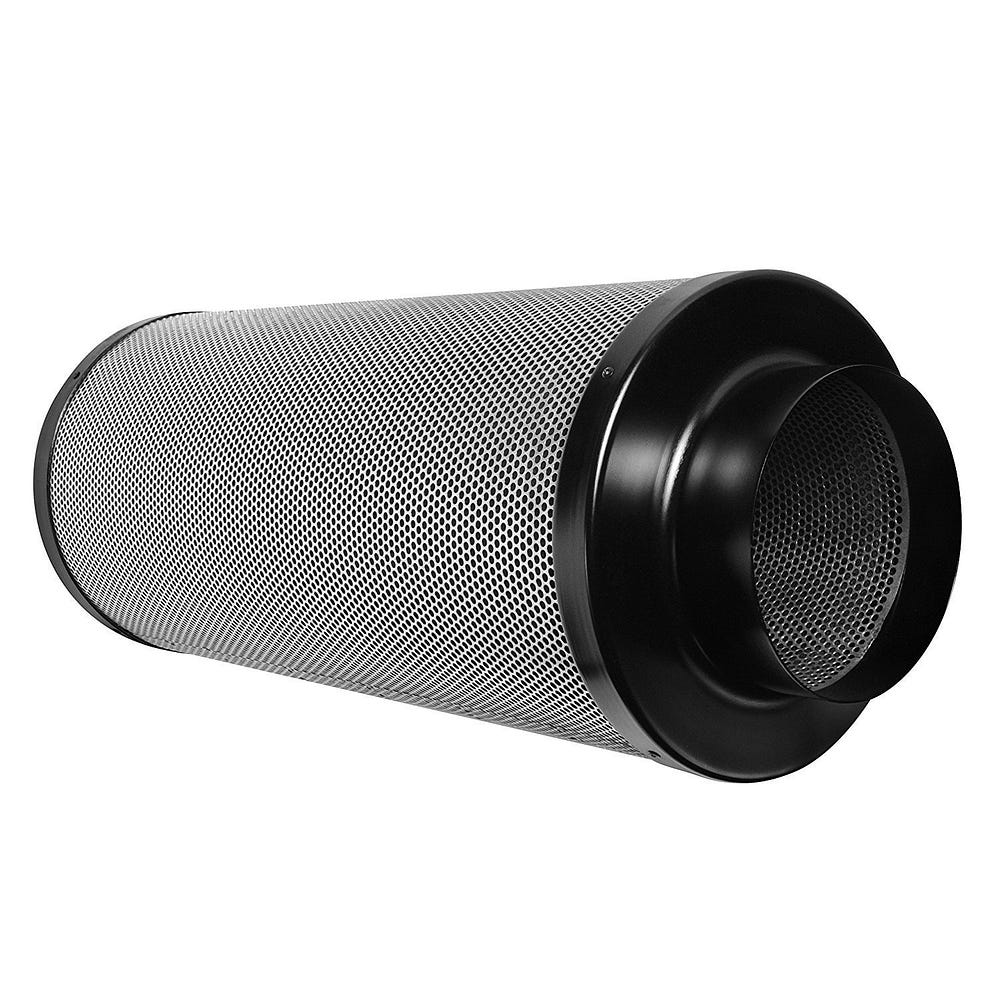
Features:
Use the top grade RC-48 Charcoal Carbon from Western Australia ONLY. The carbon Bed in our filters is 3.8CM thick and machine packed with extremely small granulesHigh-quality RC48 carbon has a bigger specific surface area, providing higher absorption and longer life rating. Pollutants will be effectively captured by the thicker carbon layer. The open mesh delivers 53% high airflow, while the structure provides stronger support. The free premium PRE-FILTER blocks 99% of the particles, effectively preventing the filter from being clogged. Equipped with reversible heavy-duty flanges, stainless-steel meshing, and PRE-FILTER. The tapered base provides optimal air inlet Angle. Designed to eliminate odors and chemicals, the carbon filter ideal is for grow tents and hydroponics rooms, indoor planting tents, basements, and kitchens.
TerraBloom 4" Air Carbon Filter for Grow Tent
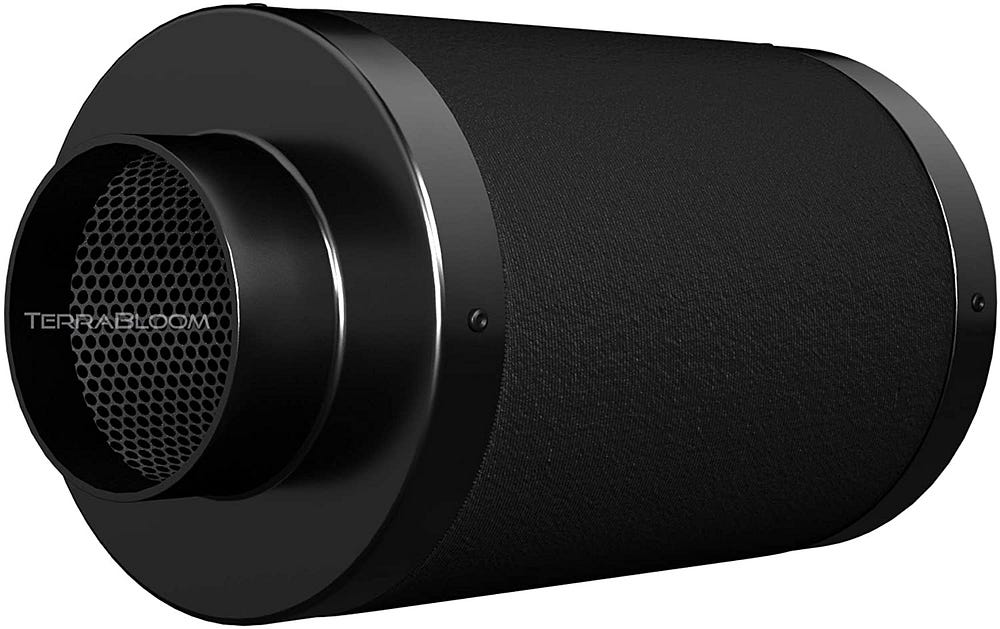
Features:
TerraBloom premium carbon filters have an industry-leading 1.8” (46mm) deep carbon bed that is at least 20% thicker than the competition. The filters scrub air better and have a longer lifespan. Only the highest grade, granular Australian activated charcoal, gives you better adsorption and superior carbon porosity to capture odors, VOCs, and other airborne pollutants in growing, laser engraving, food processing, and manufacturing applications. This charcoal scrubber can be installed both inside and outside the grow tent and is capable of filtering the air in both directions. Whether you want to use it as an exhaust or intake. You can pull air through the filter and out or push air into the filter and out of your grow room, it will work just as well.
Why Does Weed Smell?
As plants evolve over thousands of years, they develop traits that are better for their survival. There are many plants in the Congo forests which have become more attractive over the years so that flies can be attracted and then be trapped! There are some which have developed other tastes such as a sweet smell so that they can be pollinated with ease. Similarly, the marijuana plant has developed a strong stench which is beneficial for them to be identified by humans but drives off any animals, pests, or insects which might damage the plants. This smell in the plant is attributed to terpenes.
There are many different compounds present inside the body of the marijuana plant and the most important of them which is responsible for the smell is the terpene called ‘myrcene’. Marijuana isn’t the only plant that carries myrcene, as it can be seen in a number of other plants, most famously mango and thyme. However, in other plants, due to different chemical compositions and how other compounds react with it, myrcene may not necessarily give out a skunk-like smell. This is the most general smell of weed.
However, myrcene isn’t the only terpene present in weed, and in some other strains, it might not be as dominant. Hence, different strains have different smells based on their dominant terpene profile. Growers can actually increase or decrease the smell of their weed while they are growing the plant by using different methods, particularly during the drying phase. If you remove the sugar leaves of a plant in the early phase of drying, the smell tends to be less intense. If you keep them on for longer, it tends to be more intense.
Buyer’s Guide to Carbon Filters: What to Consider Before You Buy One?
Here’s a list of things that you need to consider:
Air Flow
The bigger your grow room is, the higher amount of airflow you would require. This is usually measured in CFM (cubic feet per minute). The higher the amount of air that can be sucked in, the better it is for the growers of a larger room. For a small grow room or a grow tent, something like 150CFM would also work, but as the size of your room increases, you’ll need a carbon filter that can accommodate a higher airflow too.
Size
The size of your carbon filter is also important. It is depending upon the size of your ducting and the opening in your tent that you determine how big a carbon filter you should be buying for your grow tent or your grow room. Carbon filters generally come in four-inch, six-inch, and eight-inch variants.
Carbon Quality and Thickness
Generally speaking, the better the quality of the carbon, the more odor it can trap. Most growers prefer using a carbon filter that carries the Australian virgin charcoal, which is best suited for trapping the odors of weed. Besides the quality of the carbon that is being used, another factor that comes to play here is the thickness of the carbon bed. The thicker the carbon bed, the better it is at trapping the odors.
Durability
Since you’re investing anywhere between $50 to $150 in buying a good carbon filter/kit, you better look forward to buying one which is durable and can last you for a long time. Besides that, most people are also looking forward to getting a carbon filter that is portable in size and doesn’t weigh too much either.
Is it a Complete Kit?
Growers, particularly those who are new to growing weed and are just starting out, would rather buy a complete air filtration kit rather than go for a separate filter and separate ducting. Besides, getting a complete filtration kit would ensure that you are getting stuff that fits into each other well and is designed to function together — giving you better efficiency in terms of overall performance too.
Lifespan, Cost, and Warranty
These three are pretty simple. The longer the lifespan and the warranty, the better it is for you. Many carbon filters also come with extra pre-filters which can be replaced when the current ones get clogged. Warranty is usually quite small on these carbon filters (if any) — but the longer it is, the better it will be for you. Lastly, while these are not very expensive devices, you’ll find most carbon filters priced at about $40-$70, while some premium ones are going north of $100! The basic idea here is — the bigger the size and the higher the airflow, the pricier they are going to be.
Conclusion
Your best carbon filter for grow rooms needs a filter to stop odor from escaping and also to keep bugs out of the system. A carbon filter is the best choice since it’s reliable and relatively quiet. They are only as effective for indoor growing as the carbon in them, so when choosing a filter, go for the best carbon filter for the growing room, one that has high-quality activated charcoal and has plenty of it. Thicker carbon filter beds mean a longer lifespan and more effective odor control and filtration.
Kairos Cultivator Dry Trimmer VS GreenBroz 215 Dry Standard Trimmer
October 09, 2021
So you’ve harvested your cannabis plants after months of taking care of them? Great! If it is a small batch or low-yielding seeds you’ve planted, you could probably trim them by hand to smaller buds that you can grind in your weed grinder and finally enjoy.
However, if you’re running a cannabis business, or just have a lot of buds that need to be trimmed this can be a very time-consuming task. This is where the bud trimmer steps in.
A bud trimmer is a cannabis grower’s best friend and you will enjoy its use to the fullest each time you use it. But depending on your requirements, a simple bud trimming by hand may not be enough to do the job.
But if you’re going to ask which bud trimmer is the best, the answer depends on your needs with consideration to several factors.
Bud trimming machines fall into 3 categories: manual bud trimmers, automatic bud trimmers, and industrial bud trimmer machines. Then you also get wet and dry bud trimmers.
Wet bud is fresh flowers that have just been harvested, while dry refers to flowers that have been dried and cured. Both wet and dry trimming have advantages and disadvantages.
Trimmers range from trimming scissors for trimming small amounts to big industrial machines that do the work of 75 people trimming by hand.
If you run a large operation, you should know how many pounds per hour you need to be able to process and this will, in turn, dictate whether you can get away with manual sheers or if you’ll be better off investing in an automated commercial solution.
Kinds Of Trimming
When choosing a cannabis trimmer, you need to familiarize yourself with the two modes of trimming; wet and dry.
Wet trimming is the most preferred method and happens immediately after harvesting, right when the leaves are still alive on the vine. It is easier to remove the sugar leaves since they extend outwards due to their high moisture content. Wet trimming ensures that the plant dries even faster.
Dry trimming happens when the plants have lost some of their moisture. It happens when you leave the plants in an environment that has a controlled temperature, humidity, and light for close to two weeks. The buds will, therefore, lose their moisture slowly. When the buds dry at a rapid rate, the outside appears to be bone dry while the inside becomes dank and unaired.
When choosing between the two trimming methods, personal preference wins. Some cannabis growers appreciate both ways and consider them all before selecting a trimmer that works for them. Here is a guide that you can use to help you make a logical decision about which the best trimmer to use.
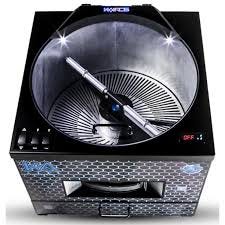
Features:
Kairos dry trimming machines are built with attention to long-term crop care. During the entire trimming cycle, a calculated amount of pressure is applied to the buds. Most wet and dry trimming machines sacrifice product quality for speed, wanting to be quick and appear efficient. The Kairos cultivator gently rolls the buds against the blade with customizable pressure from the down brushes to produce a consistent finish and premium trim for extracts. The high-precision bevel cut blades slice through your product gently, never bluntly chopping or mashing your product. This is one feature that contributes to high levels of terpene protection. Kairos Trimmers all use high-grade polymer as a lower blade buffer. Using a polymer on a metal blade keeps the machine from sticking as a result of product build-up, allowing for a smoother run and fewer stops for cleaning and maintenance.
GreenBroz 215 Dry Standard Trimmer

Features:
The GreenBroz 215 Dry Trimmer was designed to closely mimic the act of hand trimming your harvest while at the same time increasing the consistency and efficiency of your harvest process. While the 215 Dry Trimmer was primarily designed to be gentle and quiet, the 2–4 pounds per hour capacity allows you to trim your flower as quickly as anyone in the game. Our patented design allows for the gentle rolling of the flower and a trim that allows the material to maintain its curves and unique shape throughout the trimming process. Whisper if you want. Or play music while you harvest. It’s all possible with the 215 Standard Dry Trimmer as our 25-watt conveyor motor produces minimal noise. While the primary objective is to be gentle on your flower, our dry trimmers can trim quickly as well, allowing you to trim 2–4 pounds per hour while controlling the entire process through our responsive and customizable design.
When Should You Trim the Buds?
You can wet trim your buds before curing them, immediately after harvesting — when they’re still green. But you can also dry-trim your buds after they’ve been cured.
Dry trimming is more arduous to the machines since the buds have lost the juices, and the fan leaves have also changed shape — curved inwards. Since a few folded fan leaves might pass, the buds will not be as appealing as wet-trimmed buds.
Wet trimming is the easiest and can save your buds from mold infestation. When the trimming is done early, curing begins with only the cannabinoid-rich buds that continue getting potentiated during the process.
The downside to wet trimming is that you can’t hang-dry your buds. Hang-drying is the most effective way to dry your harvest; wet trimming denies you that.
Pros and cons vs hand trimming
The main debate around machine trimming is about the damage that’s done to the bud. More specifically the damage is done to the trichomes. A machine that’s too rough cuts down the overall THC content of your flower, which really defeats all the expertise that goes into growing high-quality cannabis. Some machines can even eat away small fluffy buds. Hand trimming flowers will ensure attention to detail, and remove some of the hazards to the quality, and is the easiest route to producing craft cannabis. However, when trimming hundreds of pounds, can be extremely inefficient.
Pros and cons of machine trimming marijuana
The high demand for cannabis has paved the way for new technologies and a whole range of machine trimmers. These trimmers do an incredible job of processing buds quickly, so they’re mainly used by large-scale growers producing for the low end of the market.
Pros:
Easy
Quick and efficient, saving time and money
Less messy; machine trimmers collect trim easily so you use it for other products
Cons:
Can over trim buds
They knock off a lot of trichomes, affecting potency and flavor
Stems and seeds can still make their way into finished buds
Conclusion
Trimming may be tedious but it isn’t hard to do. Experience really is the best teacher and ultimately you’ll figure out what works best for your growing style. If you’re growing for-profit and tending to six or more plants, you may want to get a small hand-powered or motorized trimmer and do the wet trim method. If you’re just growing for yourself and time and effort is not an issue, it’s probably best to keep costs down and just go with some shears and trim your buds after they’ve dried.
Atreum Lighting HYDRA-1000 LED Grow Light VS UNIT FARM UF2000 LED Grow Lights
October 07, 2021
Different LED Grow lights emit different wavelengths depending upon their spectrum pattern. These different light wavelengths stimulate different stages of plant growth, and thus while choosing the correct grow light, you must check its spectrum according to the sort of stimulation you want. For example, LED that is perfect for vegetation might not be as effective with flower development.
But Full Spectrum LED Grow Light caters to the plant stimulation at different stages according to your need, and thus you can use it for all. Full-spectrum grows light is an adjustable LED light that emits lights of different wavelengths similar to the Sun. In other words, Full Spectrum Light emits all wavelengths of light that are emitted from the sun.
Many plants not only require red or blue light but all the colors of visible light (even in a limited amount) for proper growth. For such plants, Full-Spectrum light is the best suitable option. For example, the Cannabis plant requires different lights of different wavelengths at its various growth stages, and thus it is advisable to use full-spectrum light for its healthy growth.
How Many Watts Per Square Foot For LED Grow Lights?
Watts per square foot is the most common way people determine what size LED light(s) they need, but it is not the only way. It is also not the most accurate way, but it is a good compromise between accuracy and simplicity.
Because the truth is: determining how powerful an LED grow light to get, and how many of them you need, is the most complicated of all types of lighting. This is due to the huge variation in lights and to the fact that most manufacturers flat out lie about the specs of their lights.
That doesn’t mean it’s impossible to figure out.
To grow a plant with a high light requirement, you want 30 to 40 watts per square foot of canopy area.
Let’s look at an example.
Say you have a 3×3 grow tent. That makes 9 square feet. At 30 watts per square foot, you would thus want 270 watts in total. If you went up to 40 watts per square foot, you would want 360 watts in total.
Atreum Lighting HYDRA-1000 LED Grow Light

Features:
Atreum Lighting uses the latest LEDs for high efficiency output of 2.7umol/J, delivering powerful light output for maximum higher yields compared to HPS, Blurples or other cheap LED lights. The HYDRA-1000 is the only light to feature LEDs algorithmically spaced to produce the most uniform PAR map in the industry. This means your canopy will grow more evenly than similar LED boards on the market. This grow light can be used for all stages of a plants growth cycle from seedling through flowering. The dimmable light with an actual wattage draw display is the only one of its kind that ensures you know exactly how much energy you’re drawing. The driver and controller can be set up off the light, and outside the tent to reduce heat and so as you raise and lower the grow light, you can consistently reach for the same place to adjust the light whether in or outside a grow tent.
UNIT FARM UF2000 LED Grow Lights
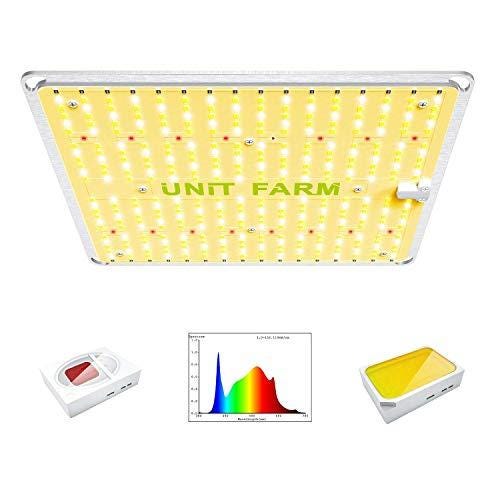
Features:
This UNIT FARM grow light is equipped with 100,000H long lifespan OSRAM diodes. 2 times longer than unknown brands SMD LED. CRI up to 90, 10 times higher than blurple light, 30% higher than cheap SMD LED. Easier to observe the health of plants. 30% more diodes than other SMD panels in the same power draw, offer 30% higher output. 368 diodes only consume 100watts. Equal to 200Watts box style blurple light and HPS. Works on 110V to 240V. Mixed 3000K, 5000K, 660nm Red, and 730nm IR Diodes, Make the lamp create a rich spectrum to covers all growth stages. The 660nm red andmake your plants have nice & big buds, Great boost yields. Single panel with the driver that isn’t fixed at the top. Can set as the main light, as sidelight around the plants. easily adjust the direction, make the light into every corner. Perfect for space budget growers.
Horticultural Lighting Metrics
To really compare and understand the LED’s performance as a grow light, you need more information than just watts, lumens, and lux values. PAR, PPF, and PPFD can help.
Pro Tip: Manufacturers can focus LED rays to the center point, letting them claim a high rating at the cost of the rest of the growing area. Also, they can fudge the intensity readings by taking them at a close distance. Check the labels critically.
PAR — The PAR value, which stands for Photosynthetic Active Radiation, is a metric intended for growing plants (finally!). PAR describes the spectrum of light that plants absorb and utilize for photosynthesis, specifically the wavelengths between 400 to 700 nanometers (nm).
PAR has major weaknesses that render it potentially useless, but at least it’s an attempt to provide information related to horticulture. A step at a time, folks.
The problem with PAR is that it lacks the weighting of light by desirability. Lux weights emissions according to the light that serves human vision, but a PAR doesn’t differentiate on behalf of plant preference.
Also, the PAR spectrum doesn’t include wavelengths outside human perception. Infrared and ultraviolet rays that plants use are excluded from the measurement. PAR isn’t enough.
Photosynthetic Photon Flux (PPF) — Another important reading is an LED’s PPF. This measures the amount of PAR light emitted per second. As this indicates the power of a source, you can calculate the light delivered to the available growing space.
Photosynthetic Photon Flux Density (PPFD) — This measures how much PAR light actually gets to the plant. It’s a spot measurement, so it only informs you about a certain point of the illuminated field — but it can be useful to compare with readings taken at the same distance.
Buying guide
When buying your LED light for indoor plants, pay attention to these features.
Light intensity
The intensity of the lightning will determine the growth of your plants. Therefore, it is better to choose the one that allows you to change the intensity. It will make it useful for a number of different plants.
Coverage
The more the better? Well, it is true here and especially if you have a number of plants. Apart from the number of plants, the area is still important. What if the light only covers half of a plant? It will show irregular growth. Therefore, the light should cover the entire plant so that it can have uniform growth.
Efficient performance and reliable
You are spending quite a sum of money on buying an LED light. They are not inexpensive, therefore, you should choose reliability. If you have bought one, it should work well for a longer time.
Conclusion
The main reason for choosing the right LED grow lights is not to be cheap. While you can certainly save on other aspects of a grow room, your lighting cannot. So look for a high-quality LED light that is long-lasting, has good reviews and delivers the right wattage.
Rosin Tech H-Frame 12 Ton Hydraulic Rosin Press VS Bubble Magic 5"x5" 1000 PSI Pneumatic Rosin Press
October 06, 2021
Rosin has become one of the most sought-after forms of cannabis concentrate on the market. It’s easy and safe to produce at home with a hair straightener and parchment paper, but it’s also easy to scale for commercial operations with the proper equipment. One of its only drawbacks is you have to have exceptionally high-quality starting material to produce great rosin, but that’s also what makes it so desirable.
Choosing the best rosin press comes down to your desire for consistency along with the scale of your operation. We’ll cover all the basics to help you make an informed decision on the best rosin press for your needs.
What You Need To Make Rosin With A Rosin Press
Before you try making Rosin, you’re going to need to pick up a few things. In addition to the Rosin Press itself, you’re also going to need a product such as Cannabis Flower for extraction, a small storage container, and potentially other accessories such as Rosin Bags. Fortunately, all of these things can easily be bought online.
You can buy Rosin Presses online in many forms depending on how good you want your Rosin to be. Cannabis manufacturers often use large, industrial Rosin Presses for extracting as much Rosin as possible. However, even a simple portable Rosin Press can be used for making high-quality Rosin dabs in minutes, and they’re easy enough for anyone to use.
As for what to use for extraction, you have many options. Cannabis Flower is ideal for creating high-THC Rosin extracts. You can also use Kief or Hash if you prefer. These products are only legally available in certain states.
Certain accessories can also help with the Rosin extraction process. You’ll need to wrap your chosen product in Parchment Paper before extracting Rosin to stop it from sticking to the plates. You’ll also need Rosin Bags if you’re planning to extract Rosin from Kief or Hash. You should also get some Silicone Containers and a Collection Tool for scooping and storing your Rosin.
Rosin Tech H-Frame 12 Ton Hydraulic Rosin Press
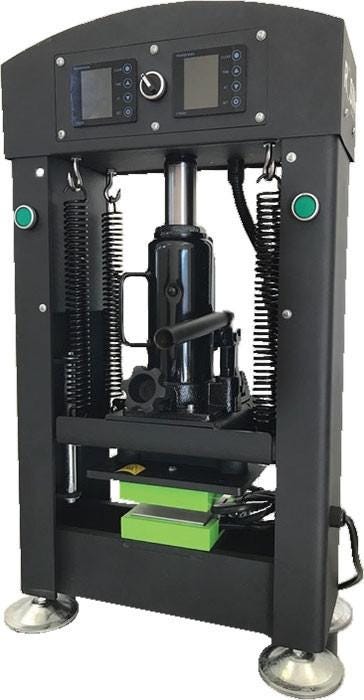
Features:
This Rosin Tech Rosin Press is built for our commercial producers. This particular Rosin Press is built for heavy-duty pressing and can achieve top-quality yield. Hydraulic presses can lift and move a load with ease. Hydraulic presses also have the added benefit of using hydraulic oil which is not compressible allowing for a smooth press each and every time. When we compare this to other presses, for example, an air press, the compression may become jerky and uneven as the air pressure changes leading to an uneven yield. This Rosin Press comes with the ability to manually use the hydraulic force or can make the use of the best of both worlds and has the ability to connect to an air compressor in order to speed up the process.
Bubble Magic 5"x5" 1000 PSI Pneumatic Rosin Press
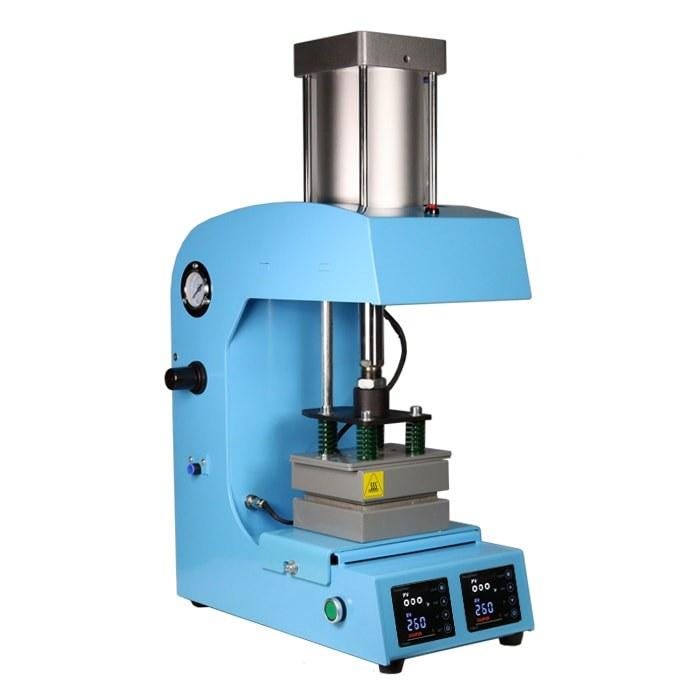
Features:
This Bubble Magic rosin press comes equipped with 5 by 5-inch heat plates, but they can be changed for 4 by 6 or 6 by 8-inch plates. Control both your top plate and bottom plate separately and use the built-in digital LED timer and temperature controller to make sure you are getting the most out of your pressing session! With a temperature range of 0° to 750° Fahrenheit, you can dial in the plates to the perfect temperature you are trying to achieve. This press requires an air compressor to run (not included), delivering pressure in all the right places.
How To Use A Rosin Press
Once you have everything you need, the process of using a Rosin Press and making quality Rosin is surprisingly easy. Before you start, you’ll need to get your chosen product ready. Cannabis or Hemp Flower should be placed between two pieces of parchment paper. Kief or Hash should be placed in a Rosin Bag before being wrapped in parchment paper.
Preheat your Rosin Press by turning it on. If your Rosin Press has adjustable temperature settings, then 220–250°F is ideal for extracting higher yields of Rosin. However, lower temperatures of 150–220°F will give you more terpenes, resulting in more flavorful Rosin dabs.
Once the plates are hot, apply some gloves and place your wrapped cannabis or hemp between the plates. You can then press down on the packaged product firmly for a few seconds and you’ll notice Rosin emerge from the edges. It usually only takes a single press to extract plenty of Rosin, although you may want to repeat the process to extract more.
After extracting your Rosin, turn your Rosin Press off and allow the finished product to cool. You may even want to place it in the fridge briefly. Once it’s cool enough, use your collection tool to scoop up all of the Rosin and place it in a small silicone or glass container. You can then use it whenever you wish.
What You Should Know While Selecting the Rosin Press
Size and Shape of the Plate
The size and shape of the plate depending on the amount of material you will be pressing more often.
First, when the rosin flows out from your material, it needs to slide out at the soonest time possible, as the heat from the plates can affect the quality of these extracts.
Thus a small plate would seem ideal, but it will also mean you can only work on a small amount per batch.
Having a larger plate allows you to extract more and reduce the instances of unpressed plant material. But that comes at the expense of rosin sliding out slower.
That’s where having rectangular plates come in.
Rectangular plates work best when extracting large amounts of material, and they can slide out without much delay due to the short travel distance.
Amount of Pressure
Does more pressure mean much better for rosin?
Unfortunately, that is not true.
Depending on the material you plan to extract, you need to have the right amount of pressure to get the best results.
Anything below it won’t let you make the most of your material. More pressure than needed can result in blowouts, which can affect the taste of your extracts.
So how much pressure do you need?
If you are mostly pressing buds, you can use a rosin press that can provide force between 600 to 1,000 PSI.
For those extracting kief, you would want a rosin press with a force range between 300 and 700 PSI. You can use this setting for dry sift hash, although you may want to work within the lower limits.
What’s the Ideal Temperature?
The thing is, the amount of heat depends on the strain you are extracting from.
While you can experiment with the amount of heat, you should be aware that using more heat can reduce the amount of pressure needed but can compromise the quality of the rosin.
Meanwhile, lower temperatures can produce more potent rosins but need more pressure, which is also risky due to the risk of blowouts.
If you are looking into extracting rosin from buds, you should look at heating the plates from 175 up to 240 degrees Fahrenheit. With the right settings, you can expect a yield of up to 25 percent.
For extracting hash, kief, or dry sift, you should have heating plates that can go from 170 to 190 degrees Fahrenheit. You can get up to 70 percent yields if done in the right settings.
Conclusion
Now that you have the considerations in mind, you can make an informed decision when you buy a rosin press.
You don’t have to fall for any marketing hype, as you can base your decision on what you need and how you see yourself using the rosin press in the future.
Happy extracting!
3 Best microscopes For Trichomes 2021
September 25, 2021
There lie many particles around us that are relatively very tiny in size and cannot be seen by the normal view as well. So, there you need a microscope to view the cellular structures of that particle.
Microscopes are highly used in observing & analyzing small objects. They are not only used in micro-biological, histological works but also in electronics to make circuits for their better magnification skill.
But it is very problematic for you to select the right one. After considerable amounts of research, we’re pretty much confident enough to provide you the five-best microscope for trichomes.
Let’s take a look & help you to find your intended microscope that you’re wished for.
Kinds Of Microscopes
In the world of microscopes there are different attributes which designate a microscope to be one kind or another (stereo, compound, inverted, etc.). For our purposes, we will focus on only 3 types of basic microscopes.
Digital
Traditional
Compact
Digital Microscopes
All the microscopes on this list are technically digital microscopes. This is the time we live in, where everything is digital and the convenience of being able to hook a microscope up to a computer can not be ignored.
In almost every case a digital microscope is going to be the best choice as a cannabis grower. It is great to be able to store your photos digitally so you can document your harvests and track any issues with your plants over time. This would be much more difficult using traditional old school tools.
Traditional Microscopes
These are the ones you may remember from grade school, with the lenses and the little slides and the arm that you adjust with the knobs. These are excellent scientific instruments and can be used for our purposes just as well as a digital one can.
The issue here is that there is no way to easily document what you see, unless you use your phone to take pictures. Traditional microscopes do not always have their own light source either, so you may need additional equipment to see what is going on.
This type of microscope is still useful and a viable tool that scientists still use today. However, for our purposes it just isn’t as efficient and convenient as a digital model.
Compact Microscopes
These are more common now than they used to be. The technology needed to make these things is readily available and they are getting smaller and smaller!
Years ago, you would not believe me if I said there were microscopes that fit in your pocket and can take pictures, too!
The convenience of being able to carry a microscope around is a bonus. Compact microscopes can often give you the same level of results as the larger models, so there is not necessarily a downside to using them.
However, the argument can be made that if you are doing serious studying, you can’t beat a stand alone stationary style microscope.
ECO Farm Pocket LED Microscope Magnifier
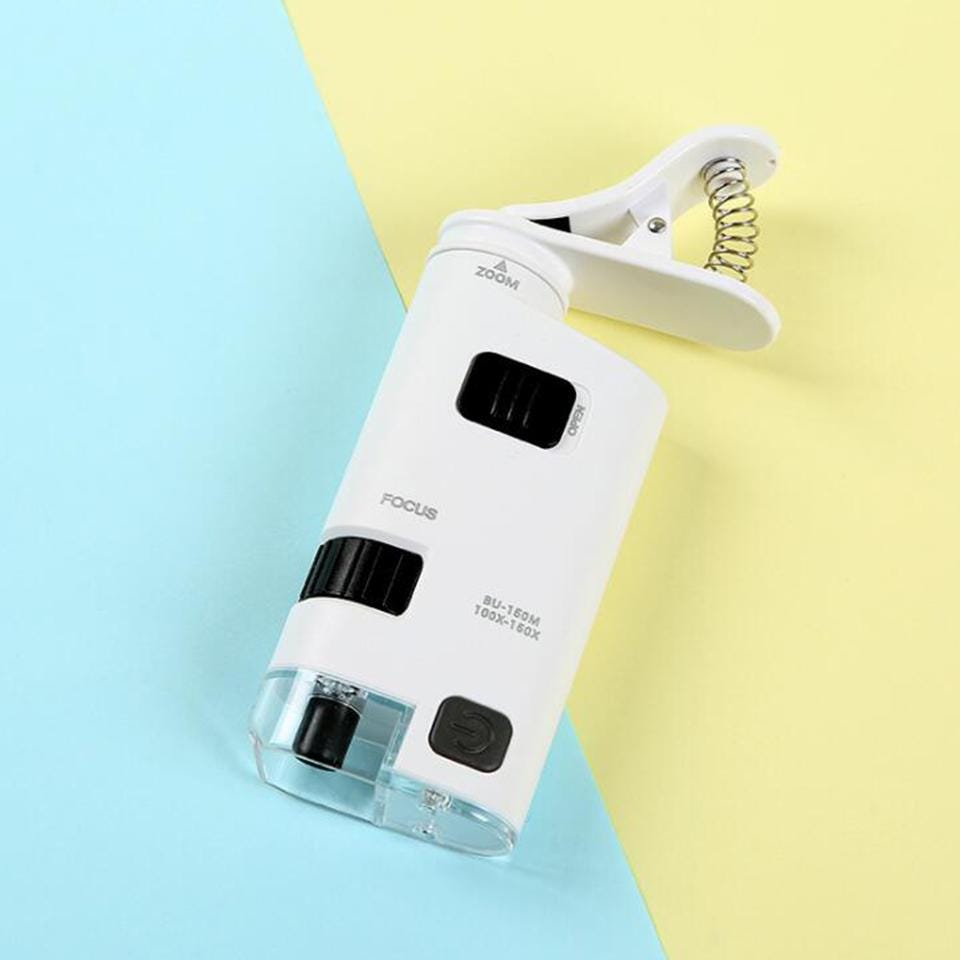
Features:
This ECO Farm Microscope Magnifier is an easy to use LED and UV Lighted Pocket Microscope. Field Microscope Contains a Built-In Stand Alone UV and LED Flashlight | There is also an additional Built-In LED light to be used in Conjunction with the Microscope, which is perfect for printing, medicine, horticulture, coins and stamps, education, geography, house living and office. 1 bright led light provides sufficient light at any condition. The led let you see details even in low-light or darkness.
Grower’s Edge Illuminated Microscope 60x
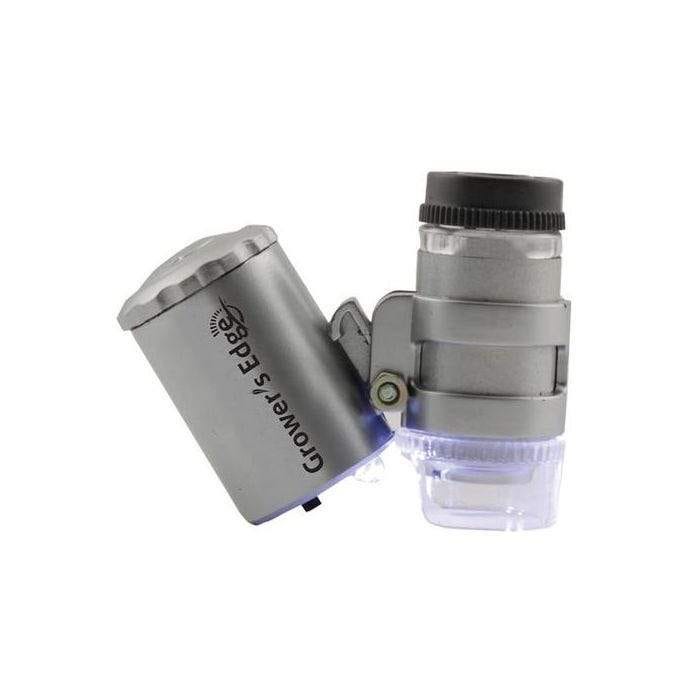
Features:
The Grower’s Edge Illuminated Microscope 60x is perfect for viewing your plants extra-close to determine their health, trichome ripeness, or to identify pests. Small and compact, it fits in your pocket! There’s nothing quite like the unique structure trichomes present when looking at them magnified. Illuminated with 3 LED lights. Focus adjusting lens barrel. Battery operated (included). 60x magnification. 2 light settings: high and low.
Carson Optical MA-60 MagniScope

Features:
The MA-60 MagniScope? from Carson Optical combines three different optical devices in one; a 6x18mm Monocular, 25x Microscope and 4x Loupe. It is illuminated with 4 super-bright LED lights. Monocular Lenses: Fully Multi Coated Field of View: 420 feet at 1000 yards Minimum Focal distance: 2.5 feet| Eye Relief: 10mm
How To Choose The Right Microscope For Viewing Trichomes
Marijuana and its trichomes
Before we wrap up for the day, you should also keep some main purchasing factors in mind. You don’t want to go out and buy just any microscope of magnifying device.
Here are the main points to keep in mind before buying a microscope for viewing trichomes;
1. Magnification Capabilities
First off, you want to look for the exact magnification capabilities of the item in question. As you may have noticed from our reviews, some jeweler’s loupes are as low as 10x, or even 5x, but some of the microscopes we looked at, especially the digital ones, go up to 1000x magnification or more.
Well, 1000x magnification is overkill, but 5x is not enough. If you want something basic that works, you do want to have at least 10x magnification, and anywhere up to 100x will do fine as well.
2. Image Quality & Clarity
If you are using a regular microscope, it is the lenses that will provide you with good image quality, so make sure that the item in question features high quality lenses.
If you are using a digital microscope, you want to ensure that it has a good camera with great resolution, and that whatever display you are using can match that quality.
Great magnification capability is not going to mean much if the end result is grainy.
3. Durability & Longevity
Yes, you do want to find something that has a decent level of durability.
Of course, you do get what you pay for, so if you are looking for something decent, don’t go with the cheapest option around, but this does also not mean that you have to shell out hundreds and hundreds of dollars either.
Something mid range will do just fine for viewing trichomes.
4. Size & Portability
How large is the microscope in question? Keep in mind that handheld options are nice because they are small and portable, and more important, they do not make you remove the buds form your plants for viewing, which is a big deal.
On the other hand, larger and less portable microscopes, although you do have to break off a bud and bring it to the microscopes, they do tend to have higher quality and better capabilities overall.
5. Illumination Capabilities
Whatever you do, you should always look for a microscope that has illumination. In other words, you want it to have a light.
It will just make it much easier to see the trichomes with clarity.
6. User Friendliness
Finally, how easy is the item in question to use. Is it something that anybody can use, or is it a microscope that you have to have a PhD to use?
Something simple and straightforward will do just fine for viewing trichomes.
Conclusion
It is essential to get a microscope or magnifying glass to inform yourself better on the right time to harvest cannabis. To do this efficiently, it is important to get a magnifying glass or microscope of good quality. It is interesting to know there are dozens of affordable magnifying glasses and microscopes of good quality. Ensure you get one with the right magnification, and watch your plants closely. A good microscope or loupe will help observe your trichomes closely and harvest them at the right time.
Finally, ensure you use these plants responsibly.
Phlizon FD4000 Plant Led Grow Light VS HYPHOTONFLUX HPF4000 Full Spectrum Led Grow Lights
September 24, 2021
Growing plants indoors is an excellent way to bring in an extra layer of decoration and elevate your home’s atmosphere to a whole new level. However, as fun as this hobby might sound — keeping plants alive and flourishing can be tricky. Other than taking care of basic elements like water and soil, you must pay attention to the amount of light that your plants are getting.
Of course, having a source like natural window light is ideal — but all homes are not created equal. With less-than-sufficient direct sunlight or very limited sunny time in a year, your best bet when it comes to growing plants inside is an LED grow light. And in order to help those in need, here is our guide to the best LED grow lights for indoor plants. Let’s get to it.
Compare Different LED Light Brands Before Purchasing
Choose a brand and type that are constructed of good quality, sturdy materials. A good set of grow lights can last for as long as 10 years and will maintain their effectiveness the whole time. Customer information has indicated that the highest quality lights are manufactured in the United States.
Since your LED lights will be in use for at least 10 hours a day, every day, keep in mind that your utility bill will go up. Check out the wattage of the light set you choose. Just because they’re available up to several thousand Watts doesn’t mean that you necessarily need to purchase something that strong. In most instances, a 300-Watt set is all you will need.
One of the main considerations when it comes to purchasing grow lights is the heat output. Depending on the size of your growing area and how close the lights will be to the plant, you will want to choose the safest, lowest, and most effective heat output.
In the event that you do your research, but still end up purchasing the wrong set of lights, make sure you know the return and exchange policy for the product you’re purchasing. This will also come in handy should you discover that your light set doesn’t work as well as it was supposed to.
Phlizon FD4000 Plant Led Grow Light

Features:
The PHLIZON LED grow light is designed for greenhouse and indoor applications. The elegant design minimizes sun interference while providing greater access to the plant canopy. The ultra-effective compact design utilizes thick aluminum skin to provide superior heat dissipation and longevity. The highly efficient full-spectrum SMD chips provide ideal conditions to deliver consistent crop quality. The daisy chain dimming feature allows horticulture professionals to adjust the PPFD, increasing performance and yields. Up to 50pcs lights can be connected together. The intensity of light can be adjusted according to the needs of plants. No fans no noise, the light case is a whole aluminum radiator, Low energy consumption growing light with 6 passive-cooled bars, aluminum heat-sink, excellent performance in heat dispersing & lifespan, dropping 50% in electricity bill than HID lights
HYPHOTONFLUX HPF4000 Full Spectrum Led Grow Lights
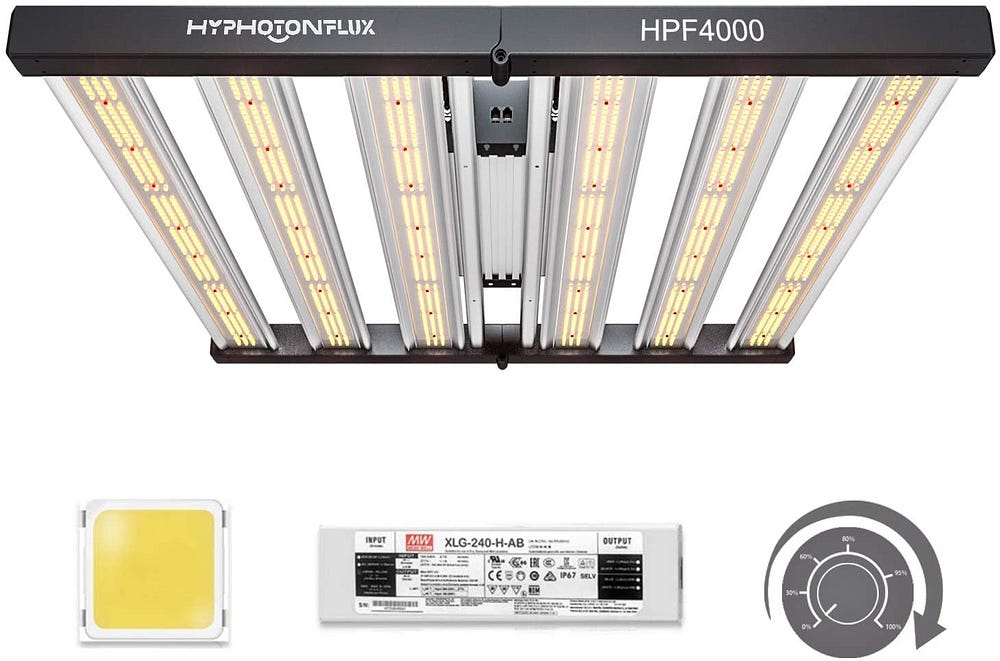
Features:
Hyphotonflux 480w LED grow light utilizes the latest in high yielding LEDs technology today-LM301B diodes, Its power is equivalent to the traditional HPS1000W, high energy efficiency with 2.7 umol/J, the veg footprint is 6 x 6 ft, the flowering footprint is 5 x 5 ft. The average yield is more than 2 grams per watt! The plant grow light have 1224 pcs LM301B leds and 48pcs deep red leds(660nm), provides the plant with the full spectrum from seeding to flowering. Ideal for all plants all stages growing, rapid plant response from seed to flower,speeds up flowering time and boost yields. A single light can be adjusted to the light intensity at liberty through the dimming knob and light switch. Besides, you can connect up to 80 lights to uniformly adjust the light intensity through the RJ14 port on the lamp, especially beneficial for large area of indoor growing and commercial planting.
What to look for when buying a LED grow light for indoor gardening
Lightweight
Everyone prefers a product that is lightweight and easy to carry. If you ever want to move the led grow light panels from one place to another, you’ll appreciate ones that are lightweight. Also, they are much easier to install. The most recent LED grow lights panels are designed to look pleasant to the eye and not take too much space. That’s what also makes them light. When you see the panels, you’ll notice that they are thin, which is very handy when you have many of these over a larger area.
Since there is a good and a bad side to everything, we wanted to mention the cons of a lightweight product. If you have a LED light that doesn’t weigh too much and hangs above plants, it’s effortless to move if you touch it or if something touches the cords. That’s why sometimes these lights are hard to stay put, which takes away from the quality of the light over your plants.
Brightness
Light intensity is one of the essential features of LED grow lights. It’s measured with PPFD, which is short for Photosynthetic Photon Flux Density. This measurement describes how many protons fall on one square meter per second. It’s actually the light that plants will absorb. If there is a high PPFD, the light is considered more effective.
People see this phenomenon through their eyes and describe it as brightness. Brightness is the sensation, while PPFD or light intensity is a measurement.
Not all plants are the same, and that’s a fact. That’s why you should educate yourself about the intensity of brightness your plants require during different stages of their growth. For example, many flowering plants require between 300 and 600 umols during their vegetative growth, while they require between 800 and 1,000 umols during their flowering stage. You don’t want the LED grow lights to be too close to the plants or too far away from them. It’s best if you follow the instructions of each manufacturer.
Energy Efficiency
LED lights are efficient in so many ways compared to other traditional types of lights. They use the same amount of electricity but use it sparingly and smartly. They preserve this energy, and while they’re plugged in, there is no energy waste.
These days, there is a high competition rate between manufacturers, so each one tries to create a more energy-efficient product. Although having grow lights turned on for long periods of time sounds scary and expensive, that’s not quite the case. LED lights are a thing of the future, and they get better each year. They use electricity, but they store it and use it more efficiently than other types of lights.
These latest LED grow lights feature an auto-shutoff feature that will help you schedule when they go off and save electricity. If you had to do that yourself, the chances are sometimes you’ll forget and end up getting a much higher bill.
Another pro of these lights is that they generate less heat, saving you money on the cooling costs in the room.
Temperature
LED lights can overheat, so that’s why it’s essential that they don’t generate too much heat and that they have a specific cooling system. Most of the LED grow light panels that you’ll see don’t have a fan, but they don’t overheat either. That’s thanks to their advanced designs. However, there are also ones that heat a lot and can negatively impact your plants’ growth.
One of the reasons brands don’t install fans is because they’ve found a way to create a design that gets rid of heat through heat sinks and doesn’t generate noise. These sinks are usually located in the back of the unit and get rid of the heat before it gets to the plants. Fans can be noisy but also do a fantastic job of keeping the device from overheating.
Value for Money
Value for money is a feature you have to consider for every product you’ll buy, not only for LED grow lights. When reading reviews, make sure that the lights that you’re buying are exactly what you’re looking for. That’s how they’ll fulfill their purpose and will be worth every dollar that you’ll pay.
Also, try finding a product that is durable and lasts for a long time. Scroll through reviews to see how other customers describe the durability of the LED light you’re interested in. It’s beneficial to offer a warranty that will cover refunds if something happens to the LED grow light. That’s the safest way to know that you’ll be getting what you paid for.
LED grow lights have a high initial cost, but they will justify the cost by lowering your electricity bills. That’s another reason why these lights bring value to your home and indoor garden. They have a long life span, which leads to the fact that they are environmentally friendly and durable.
Conclusion
It is vital that you are aware of the main features of the product that you are buying, along with the pros and cons that come with it.
May your requirements are fireproof, waterproof, durable, or efficient, the LED grow lights discussed above will surely meet your expectations.
Thus, wait no further and pick out your favorite LED light from these options, to add a unique addition to your delightful indoor gardening environment.
